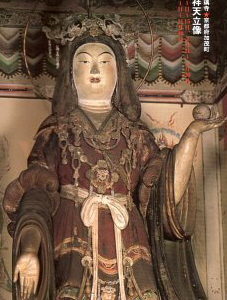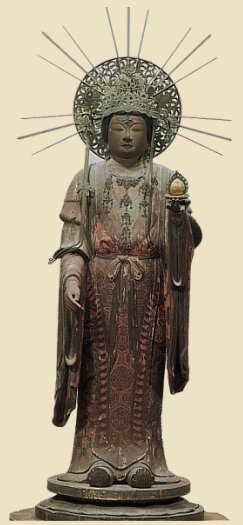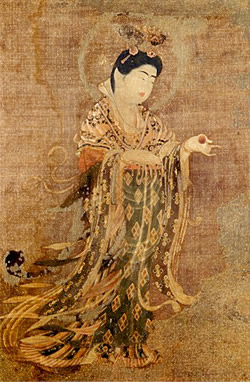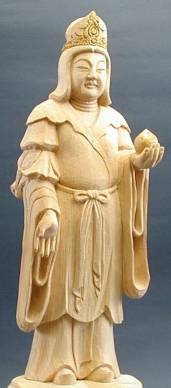|
|
|
|

Kichijōten 吉祥天, Kichijō Tennyo 吉祥天女, Kudokuten 功徳天
Goddess of Beauty, Fertility, Prosperity, and Merit
Also spelled Kichijoten, Kisshōten, or Kisshoten.
ORIGIN = HINDU MYTHOLOGY
Sanskrit = Śrī-Mahadevi, Mahāśrī, Mahasri, Lakṣmī, Laksmi
Chn. = Jíxiáng Tiān; Korean = Gilsang Cheon 길상천
In the Jimon 寺門 branch of Tendai 天台 Buddhism, Kichijōten is equated
with Myōken 妙見, the deification of the Northern Pole Star & Big Dipper.
Kichijōten 吉祥天. Wife of Vishnu (Viṣṇu) in Hindu myths; wife or sister of Bishamonten in Buddhist myths. In Japan she is the goddess of fertility, fortune, luck, beauty, and merit; among some Japanese sects she was the central devotional deity, given individual status as an object of Buddhist worship, but since the 15th / 16th century, her imagery and attributes have been largely supplanted by the Goddess Benzaiten. Even today, the two are commonly confused. Among existing sculpture and artwork, she is sometimes shown wearing a tiara containing an image of the phoenix. (Note: Must still confirm this phoenix entry.)
|
Japanese Mantra
おん
まかしりやえい
そわか
On Makashiri Yaei Sowaka
|

|
Kichijōten, Kamakura Era, Wood, Treasure of Jōryūriji Temple 浄瑠璃寺 in Kyoto, Plump body and mature face said to embody ideal feminine beauty of old China. Left hand holds Wish-Granting Jewel (Jp. = Hōjyu 宝珠; Sanskrit = Cintamani). Photo: Hidden Buddha of Japan 日本の密仏
|
|
|
Sanskrit Seed
Pronounced SRI
in Japan
|
|

|

Kichijjōten (Mahasri), 1078 AD, Heian Era.
Wood with pigments, 116 cm.
Treasure of Hōryūji Temple (Nara).
Left hand holds Wish-Granting Jewel (Jp. = Hōjyu 宝珠).
Photo courtesy of temple exhibition catalog.
|

Kichijjōten
Painting, Nara Period, 8th Century
Designated National Treasure
Treasure of Yakushiji Temple
Photo courtesy of Tokyo National Museum
Note of Confusion
The Tokyo National Museum dates this painting to
the Nara Period, but the Yakushiji Temple dates it to
the Heian period. The temple claims it is the oldest
surviving color painting in Japan.
|
|

 ABOUT ABOVE PHOTO. Text Courtesy of Tokyo National Museum. A rare and most magnificent Buddhist painting of the Tempyo Era (710-794), will be specially exhibited at the Tokyo National Museum (in August 2004) to commemorate the establishment of the Tokyo Branch of Yakushiji, one of the “Six Important Temples” (Rokudaiji) of Nara. Originally, Kichijoten was imported into Buddhism from Hinduism, being known as Laksmi, the goddess of beauty and prosperity. This painting is likely to have been the central worshipping piece, if not its important element, of Japanese Buddhist rituals during the Nara period (701-794). She has crescent-shaped eyebrows with full cheeks, and moves leisurely and gracefully in a striking multi-layered attire, like a Chinese beauty of the Tang dynasty, China (618-907). Yet a sacred gem on her left hand and her transparent shawl fluttering gently in the wind as she walks suggests her heavenly nature. Its renderings are not only delicate and elegant, but also infused with a stately Buddhist serenity of its own, and the painting radiates a special charm. Paintings dating back to the Nara period are a rarity even in Japan. Invaluable as a Buddhist painting, its opulent and noble spells are delightful to the eye indeed. <end quote from Tokyo National Museum> ABOUT ABOVE PHOTO. Text Courtesy of Tokyo National Museum. A rare and most magnificent Buddhist painting of the Tempyo Era (710-794), will be specially exhibited at the Tokyo National Museum (in August 2004) to commemorate the establishment of the Tokyo Branch of Yakushiji, one of the “Six Important Temples” (Rokudaiji) of Nara. Originally, Kichijoten was imported into Buddhism from Hinduism, being known as Laksmi, the goddess of beauty and prosperity. This painting is likely to have been the central worshipping piece, if not its important element, of Japanese Buddhist rituals during the Nara period (701-794). She has crescent-shaped eyebrows with full cheeks, and moves leisurely and gracefully in a striking multi-layered attire, like a Chinese beauty of the Tang dynasty, China (618-907). Yet a sacred gem on her left hand and her transparent shawl fluttering gently in the wind as she walks suggests her heavenly nature. Its renderings are not only delicate and elegant, but also infused with a stately Buddhist serenity of its own, and the painting radiates a special charm. Paintings dating back to the Nara period are a rarity even in Japan. Invaluable as a Buddhist painting, its opulent and noble spells are delightful to the eye indeed. <end quote from Tokyo National Museum>

|

Kichijōten
Modern Wooden Statue
Left hand holds
Wish-Granting Jewel
(Jp. = Hōjyu 宝珠).
Photo this Japanese site
|
|
KICHIJŌTEN (Skt. = Sri Laksmi, Mahasri, Mahadevi)
Text courtesy of JAANUS. Also read Kisshouten. Also called Kichijoutennyo 吉祥天女 or Kudokuten 功徳天. Originally an Indian (Brahman) goddess of fertility, wealth, and beauty, who was linked to Kubera (aka Tamonten), the Hindu god of the North, and Vishnu the Lord of Creation. As Vishnu's chief consort, Kichijouten was absorbed later into popular Buddhism in China and Japan. In the KONKOUMYOU SAISHOUOUKYOU 金光明最勝王経, "The Sutra of the Sovereign Kings of the Golden light", she is associated with wealth and virtue. Japanese belief in Kichijouten was widespread in the Nara period (8c), and her images , such as the sculptures at Toudaiji 東大寺 (746), Saidaiji 西大寺, Houryuuji 法隆寺 (748), and the painted portrait at Yakushiji 薬師寺 (ca.771), were worshipped as a principal image at the kisshou keka 吉祥悔過, or New Year's ceremony for welcoming good luck and sweeping out bad. In the Matrix Mandala, Taizoukai mandara 胎蔵界曼荼羅, Kichijouten appears as an attendant of Senju Kannon 千手観音, and the DARANI SHUUKYOU 陀羅尼集経 Sutra describes a Kichijouten mandara 吉祥天曼荼羅 which was used in an Esoteric Buddhist ritual to promote earthly happiness and welfare. Kichijouten is usually represented as a beautiful Tang-period court lady, wearing a richly embroidered gown and an elaborately jewelled head-dress. She is distinguished from Benzaiten 弁財天, with whom she is often confused, by the "wish-granting" jewel (nyoi houju 如意宝珠) held in her left hand, and the lotus in her right. She also makes the gesture (mudra) of charity (segan-in 施願印) with her palm open and facing downwards. The 12c sculpture at Joururiji 浄瑠璃寺, Kyoto, is typical of this latter type. Kichijouten was occasionally regarded as a sister of Kariteimo 訶梨帝母, the wife of Bishamonten 毘沙門天, and the mother of Zennishi Douji 善膩師童子, and was represented together with the latter two deities. <end JAANUS quote >
Mahasri, Mahāśrī (Jp. = Kudokuten)
Below text from Soothill’s Dictionary of Chinese Buddhist Terms: 摩訶室利, 功德天女, 吉祥天女, 功德天. Identified with Laksmi, name of the goddess of fortune and beauty frequently in the later mythology identified with Śrī and regarded as the wife of Visnu or Narayana, she sprang from the ocean with a lotus in her hand, whence she is also called Padmā, and is connected in other ways with the lotus. < M. W. De Visser > There is some confusion between this goddess and Guanyin, possibly through the attribution of Hindu ideas of Laksmi to Guanyin. <end Soothill quote>
RELATED MATTERS
Basūsen 婆薮仙. Says JAANUS: Also read Basusen. Basū, the Immortal or Sennin 仙人. An Indian sage whose Sanskrit name, Vasu, may be an alternative name for one of the Seven Rishi, or "seers." Basūsen appears as an Indian ascetic who, with Kichijōten 吉祥天, flanks Senju Kannon 千手観音 in the Taizoukai Mandara 胎蔵界曼荼羅. Thus he often appears, along with Kichijōten (although sometimes replaced by Kudokuten 功徳天, a form of Kichijōten), in paintings of Senju Kannon. Basūsen is also one of the Nijūhachibushū 二十八部衆, the twenty-eight (28) attendants of Senju Kannon. He usually appears either as an ascetic or as a fully dressed old man, and carries a text, usually a palm-leaf book. The later is a symbol of the Prajnaparamita texts, HANNYAKYŌ 般若経; the sutra of "The Perfection of Wisdom," which is central to the attainment of enlightenment and therefore to all forms of Buddhism. Basūsen is a protector of these texts and, as such, appears in paintings such as the images of Jūroku Zenshin 十六善神 (16 Protectors of Shaka Nyorai, the Historial Buddha), along with other protectors.
RELATED MATTERS
Myōken 妙見, aka Myōken Bosatsu 妙見菩薩,
aka Myōken Shin 妙見神. In the Jimon 寺門 branch of the Tendai 天台 sect, Kichijōten is equated with Myōken. Says JAANUS: “Myōken is an amalgamation of the Shinto deity Myōken Shin 妙見神 and the deity of the Northern Polar Star (Dipper). Originally a deification of the Polestar (Hokushin 北辰) but later also regarded as a deification of the Big Dipper (Hokuto 北斗) because of confusion between the two. Although popularly regarded as a Bodhisattva 菩薩, and usually referred to as Myōken Bosatsu 妙見菩薩, properly speaking she belongs to the category of divinities called TEN 天 (Skt. = Deva), and in the Jimon 寺門 branch of the Tendai 天台 sect she is equated with Kichijōten 吉祥天. She is invoked in particular for apotropaic purposes and also for the healing of eye diseases. In Japan she appears to have been widely revered as early as the Heian period, and in medieval times she came to be worshipped especially among powerful provincial clans as a tutelary deity of the warrior class, evolving into the partially Shintoized deity Myōkenjin 妙見神. At the same time she was also adopted by the Nichiren 日蓮 sect and remains the object of a popular cult today. Artistic representations of Myōken exhibit considerable diversity. There is a set of 26 paintings, all different, at Daigoji Temple 醍醐寺 in Kyoto, but generally speaking she is depicted with either two or four arms and either seated on a cloud or standing on the back of a dragon. Myōkenjin has a halo showing the seven stars of the Big Dipper and holds a sword in one hand. There is also a mandala (mandara) 曼荼羅 devoted to her, the Myōken Mandala 妙見曼荼羅.” <end JAANUS quote>
For more on Myōken, see our Myōken Page.

LEARN MORE

|
|